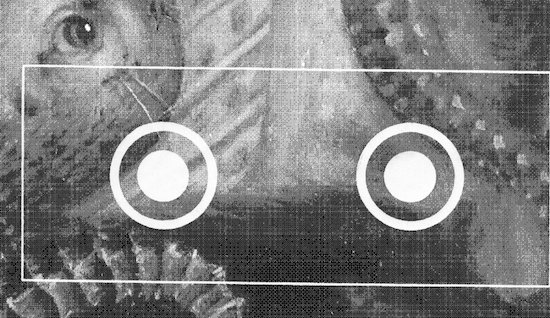The work of James Richards, according to Dan Fox, "hints at the desire in all of us to feel part of a bigger whole." The writer and Frieze was speaking at a talk upstairs at the Kunsthall in Bergen, in the midst of the city’s Borealis Festival of Experimental Music. But the simultaneity of Richards’s show there and the festival was little more than coincidence.
A happy chance, as festival curator, Peter Meanwell indicated. For even when not working directly with sound, there are distinctly musical qualities to Richards’s work, which Fox’s talk brought out and emphasised, speaking in a room above the exhibition galleries over a specially prepared soundtrack of Richards’s musical influences and associations, like Robert Hood, Steeleye Span, Laurie Anderson, and Graham Lambkin. There is, Fox suggested, "an electronic rustic" at work in Richards’s art, "almost a science fiction folk music."
Described by Richards himself as a single work "‘smeared and spread across multiple rooms," Crumb Mahogany fills up four galleries with sound and moving images. By far the largest of these rooms, at the west of the building, is almost bare, aside from a pair of heavy, grey curtains covering opposing walls to dampen the sound, and a ring of six loudspeakers encircling a few benches.
Taking a seat in the middle, you hear sounds swirling around you: over to my right someone is breathing deeply; a piano vamps away moodily behind me with the noise of traffic building up behind it and ifnally overcoming it completely; a deep bass whoop rises up to my left, its pitch ascending seemingly to infinity, like Shepherd Tones, and gradually moving forward and round, from one speaker to the next, before stopping abruptly with the crunch of broken glass.
The whole mix is imbued with a sense of melancholy, as if it were haunted by obscure regrets. What elements of traditional, diatonic music that do drift in and out are invariably in a minor key. Vocal sounds are looped, reversed, pitched down and sped up, doubled by ring modulation. The long, long reverb trails hanging on the tails of many of these sounds are suggestive of vast, cavernous spaces. We hear the crackle of a record’s run-out groove, snatches of melody lurching in and out of view like scenes passed on the motorway.
There is a dreamlike quality to the way things come in and out of focus, oddly familiar sounds not quite recognisable. Is this the meaning of the heavy breathing that returns now and again, always in the same space in the stereo image? But if we are party to a some dream in sounds, how are we to interpret it? What could be the latent wish whose fulfilment is concealed by the patchwork texture of the dreamwork?
Richards’ films, "smeared and spread" across five different screens in three different rooms are all presented in portrait orientation, like a mobile phone screen, with each one consisting of two vertically superposed tracks of moving images: a close-up of an eye through a jeweller’s lupe, under footage of birds in flight which then cuts to the crashing of surf; slides passing beneath a microscope beneath an almost still image of some sort of textured surface in close-up. The picture, in each case, has a washed out, desaturated look; a world drained of its colour.
These are all films of things, but they become abstract through their arrangement and juxtaposition, like elements of a code or figures carved into a totem pole. The films loop. There is no narrative arc or closure inherent to the footage on any individual video monitor. Rather, we, as spectators, activate multiple potential stories as we move through the space.
This partialness or lack of self-sufficiency is also internal to the images themselves, many of which capture only a portion of something, or appear obscure by dint of being too close-up. They shift, with our viewpoint, between things and forms, objects and textures. Fox, in his talk, had described this aspect of the work as "corporal – the parts not quite making a whole."
In the press release, Richards describes how he assembled these streams of images. “I want to assemble things that push and pull ones feelings," he writes, "rather than sticking to single points or statements. Moving from high drama to the erotic, from the violent to the banal, it’s the specifics of these sensations that I’m trying to tap, while working very precisely with the shifts and interruptions, climaxes and anticlimaxes, as well as the confusions and resolutions that can occur when disparate elements convene over time…
"There was a period around 2009 when I was gathering a lot of VHS tapes from charity shops in London; they were cheap, plentiful, ten for a pound. I would scoop them up and sit in my studio, going kind of numb, watching on fast forward – waiting for a moment or glimpse of something that would snap out at me, that would stick. Its from these moments that a work would start to form”
Dan Fox had noted the influence on Richards of ambient records by the KLF and Future Sound of London, some of the earliest records to make extensive use of samplers. It’s an approach that comes across very strongly in these works: sounds and images are mashed and blended together, the familiar and the obscure rubbing up against each other according to structures that are much closer to music than narrative film or any conventional image-based work. Fox had quoted Richards’s description of the act of sampling as being like "listening to someone listening to something." With this work we seem to be listening – and watching – from deep inside that someone else’s mind.
James Richards’s Crumb Mahogany is at Bergen Kunsthall. Later in the year it will travel to the ICA in London


